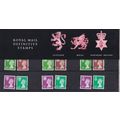Glastonbury, Somerset - Holy Thorn flowering in winter - Walter Scott postcard
- Condition : Used
- Dispatch : 2 Days
- Brand : None
- ID# : 128323681
- Quantity : 1 item
- Views : 658
- Location : United Kingdom

- Seller : justthebook (+1699)
- Barcode : None
- Start : Mon 19 May 2014 15:22:24 (EDT)
- Close : Run Until Sold
- Remain : Run Until Sold
Checks/Cheques
 for 1 item(s) edit
for 1 item(s) edit
Shipping Calculator
More Listings from This Seller view all
Seller's Description
- Postcard
- Picture / Image: Glastonbury Holy Thorn flowering in Winter Time
- Publisher: Walter Scott (CB132)
- Postally used: yes
- Stamp: 11&half p. grey Machin
- Postmark(s): Salisbury 8 Oct 1981 slogan
- Sent to: Chingford, London E4
- Notes / condition: slight wear in one corner
Please ask if you need any other information and I will do the best I can to answer.
Image may be low res for illustrative purposes - if you need a higher definition image then please contact me and I may be able to send one.
------------------------------------------------
Postage & Packing:
UK (incl. IOM, CI & BFPO): 99p
Europe: £1.60
Rest of world (inc. USA etc): £2.75
No additional charges for more than one postcard. You can buy as many postcards from me as you like and you will just pay the fee above once. (If buying postcards with other things such as books, please contact or wait for invoice before paying).
Payment Methods:
UK - PayPal, Cheque (from UK bank) or postal order
Outside UK: PayPal ONLY (unless otherwise stated) please. NO non-UK currency checks or money orders (sorry).
NOTE: All postcards are sent in brand new stiffened envelopes which I have bought for the task. These are specially made to protect postcards and you may be able to re-use them. In addition there are other costs to sending so the above charge is not just for the stamp!
I will give a full refund if you are not fully satisfied with the postcard.
----------------------------------------------
Text from the free encyclopedia WIKIPEDIA may appear below to give a little background information (internal links may not work) :
*************
The Glastonbury Thorn is a form of Common Hawthorn, Crataegus monogyna 'Biflora'[1] (sometimes incorrectly called Crataegus oxyacantha var. praecox), found in and around Glastonbury, Somerset, England. Unlike ordinary hawthorn trees, it flowers twice a year (hence the name ""biflora""), the first time in winter and the second time in spring. The trees in the Glastonbury area have been propagated by grafting since ancient times.[1]
It is associated with legends about Joseph of Arimathea and the arrival of Christianity in Britain, and has appeared in written texts since the medieval period. A flowering sprig is sent to the British Monarch every Christmas. The original tree has been propagated several times, with one tree growing at Glastonbury Abbey and another in the churchyard of the Church of St John. The ""original"" Glastonbury Thorn was cut down and burned as a relic of superstition during the English Civil War, and one planted on Wearyall Hill in 1951 to replace it had its branches cut off in 2010.
According to legend, Joseph of Arimathea visited Glastonbury with the Holy Grail and thrust his staff into Wearyall Hill, which then grew into the original thorn tree.[2][3][4] Early writers do not connect Joseph to the arrival of Christianity in Britain, and the first literary source to place him in Britain appeared in the ninth century.[5] The historicity of Joseph's presence in Glastonbury remains controversial, but the thorn is first mentioned in an early sixteenth-century metrical Lyfe of Joseph of Arimathea. The anonymous author notes that the thorn was unusual in that it flowered twice in a year, once as normal on ""old wood"" in spring, and once on ""new wood"" (the current season's matured new growth) in the winter. This flowering of the Glastonbury Thorn in mild weather just past midwinter was accounted miraculous.[6]
At the time of the adoption of the revised Gregorian calendar in Britain in 1752, the Gentleman's Magazine reported that curious visitors went to see whether the Glastonbury Thorn kept to the Julian calendar or the new one:
Glastonbury.—A vast concourse of people attended the noted thorn on Christmas-day, new style; but, to their great disappointment, there was no appearance of its blowing, which made them watch it narrowly the 5th of January, the Christmas-day, old style, when it blowed as usual.
- Gentleman's Magazine January 1753
The original Glastonbury Thorn itself was cut down and burned as a relic of superstition by Cromwellian troops (or 'Roundheads' by another source) during the English Civil War.[2][7]
The custom of sending a budded branch of the Glastonbury thorn to the Queen at Christmas was initiated by James Montague, Bishop of Bath and Wells during James I's reign, who sent a branch to Queen Anne, King James I's consort. A spray of Holy Thorn from the Glastonbury Thorn tree was sent to the Sovereign each Christmas by the Vicar and Mayor of Glastonbury.[8] The thorn also featured on British Postage stamps on the 12p and 13p Christmas stamps in 1986.[9][10]
The Glastonbury Thorn was once again attacked and its branches cut off, in this case the 1951 specimen that was growing on Wearyall Hill on the southwestern side of the town, on 9 December 2010.[2][3][4][11] In March 2011, it was reported that a new shoot had appeared on the damaged tree.[12] However, as these new shoots came up they would suspiciously disappear a few days or weeks later.[13]
On 1 April 2012 a sapling grafted from a descendant of the pre-1951 specimen was planted by the landowners working with Glastonbury Conservation Society and consecrated, but it was snapped in half and irreparably damaged 16 days later.[13]
Many have tried to grow the Glastonbury Holy Thorn from seed and direct cuttings, but in the later part of the 20th century all attempts reverted to the normal hawthorn type, flowering only in spring.[14]
This tree has been widely propagated by grafting or cuttings, with the cultivar name 'Biflora' or 'Praecox'. An early antiquarian account by Mr Eyston was given in Hearse's History and Antiquities of Glastonbury, 1722 : ""There is a person about Glastonbury who has a nursery of them, who, Mr. Paschal tells us he is informed, sells them for a crown a piece, or as he can get.""[15]
The tree in the grounds of the church was pronounced dead in June 1991, and cut down the following February.[16] However, many cuttings were taken from it before its destruction. The pre-1991 thorn in the grounds of Glastonbury Church is said to be a cutting from the original plant which was planted in secret after the original was destroyed. Now only trees budded or grafted from the original exist, and these blossom twice a year, in May and at Christmas. The blossoms of the Christmas shoots are usually much smaller than the May ones and do not produce any haws. Plants grown from the haws do not retain the characteristics of the parent stem.
The present ""sacred thorn tree"" at the Church of St John was grown from a local cutting, like many others in the neighbourhood of Glastonbury. The large tree had been in the churchyard for eighty years. It was planted by Mr George Chislett, then head gardener of Glastonbury Abbey. He also learned how to graft Holy Thorn cuttings onto the root of blackthorn stock, and so preserve the “miraculous” Christmas blossoming characteristic. His son, Wilf, sent Holy Thorns all over the world, including to Washington, Canada, New Zealand and Australia.
Luckily, trees survive from earlier grafts to perpetuate the Glastonbury legend, among them two other Holy Thorns in the grounds of St John’s. The blossom sent to the Queen now comes from one of these. At the end of term, the pupils of St John’s Infants School gather round the tree in St John’s parish churchyard on the High Street. They sing carols, including one specially written for the occasion, and the oldest pupil has the privilege of cutting the branch of the Glastonbury Thorn that is then taken to London and presented to Her Majesty The Queen. In 1965, the Queen erected a wooden cross at Glastonbury with the following inscription: ""The cross, the symbol of our faith, the gift of Queen Elizabeth II, marks a Christian sanctuary so ancient that only legend can record its origin.""
type=printed postcards
theme=topographical: british
sub-theme=england
county/ country=somerset
number of items=single
period=1945 - present
postage condition=posted
Listing Information
| Listing Type | Gallery Listing |
| Listing ID# | 128323681 |
| Start Time | Mon 19 May 2014 15:22:24 (EDT) |
| Close Time | Run Until Sold |
| Starting Bid | Fixed Price (no bidding) |
| Item Condition | Used |
| Bids | 0 |
| Views | 658 |
| Dispatch Time | 2 Days |
| Quantity | 1 |
| Location | United Kingdom |
| Auto Extend | No |




















